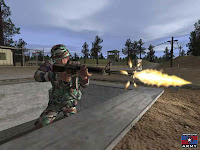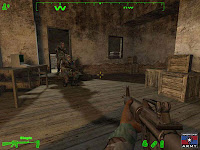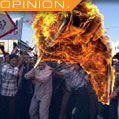


Remember the movie "The Last Starfighter?" It was a mid-eighties sci-fi flick notable for only two things: It was the first feature film to use computer generated special effects and it introduced the comical idea of military recruitment through video games. The premise involved an alien race, desperate for starfighter pilots, distributing Atari-like arcade games to various planets and recruiting the highest-scoring players for service in their interstellar war. (Advanced aliens? Pah! The game wasn't even 16-bit!).
But as is too often the case, life has imitated fiction (I can't bring myself to refer to "Starfighter" as art). The United States Army, in its infinite wisdom and budget, has recently unveiled a video game of it's own – America's Army.
Based on the popular Unreal engine,
America's Army is an online video game that allows players to slip into the role of an American soldier. You proceed through basic training and, depending on how well you do, have the opportunity to advance to sniper school (modules for Ranger and Airborne schools will be released soon, according to americasarmy.com)
Cool? Definitely. A practical use of taxpayer money? Well, that depends on how you look at it.
The military is a notorious big spender. Even before the recent controversies involving rampant credit abuse among the officer corps, our uniformed services were well known for their thousand-dollar toilets and multi-million-dollar aircraft. And they love to spend our taxpayer dollars on advertising. The Army and Air Force have spent millions promoting their new identities; all five military branches have invested in enormous recruitment campaigns. The mere fact that we can recite their slogans – "An Army of one," "The few, the proud, the Marines," "Cross into the blue" – is testament to their collective marketing machine.
America's Army took three years to build and has, to date, cost taxpayers 6.3 million dollars. That may sound like a lot, but compared to all the "Army of one" commercials running prime time it's small change. What's more, America's Army has two distinct features in its favor: it targets a specific market of people very successfully and it's fun as hell.
Lieutenant Colonel Casey Wardynski, the originator and director of America's Army, saw a niche into which the military could easily slip. Online multiplayer war games are extremely popular and, under the Army's subtle direction, could be an extremely effective way to present the values of what it takes to be a solider.
The U.S. Army is using America's Army to recruit people through video games. Sounds like the premise to a movie.
The game is amazing, though. Working with a team of other online players, you fight a variety of missions against ethnically-ambiguous terrorists. The scenery and graphics are stunning – the game play fast and compelling.
Perhaps the neatest interface innovation America's Army brings to the table is that everyone is the hero. In the conventional online model, one group of players would act as soldiers and another would act as terrorists. In America's Army, however, every online player is a US soldier. While two competing teams of players would see themselves as the good guy in green fatigues, the opposing team is always rendered as the terrorists. It's all a matter of perspective– one I'm sure wouldn't be lost on Lt. Col. Wardynski or Donald Rumsfeld. Post 9/11, America's Army would have had their funding cut if they had been encouraging online terrorism.
America's Army is just the vanguard of a wave of military video games coming our way. Over the next five years the Army is planning a series of games, from interpersonal role-playing games like their "Soldier" project to developments that would allow career America's Army players to rise in rank and command platoons of lower ranking e-recruits online. Whether or not the Navy or Air Force follow suit is anyone's guess (the Navy website is practically a video game already).
"The Last Starfighter" these games are not. America's Army rocks. Only time will tell if it actually drives online gamers to their local recruiter.
fb
 When you think of great film critics you think of Shallot, Siskle, Ebert, Roper (whoever he is). Add Mr. Cranky to your list.
When you think of great film critics you think of Shallot, Siskle, Ebert, Roper (whoever he is). Add Mr. Cranky to your list.















